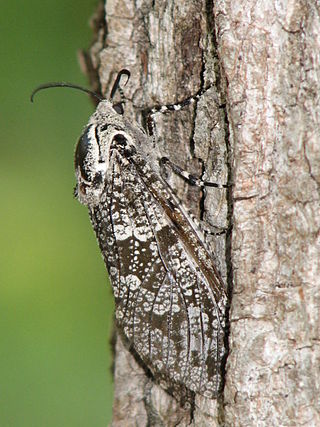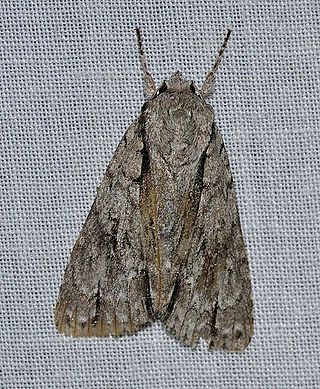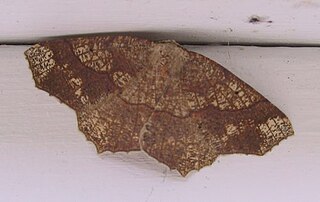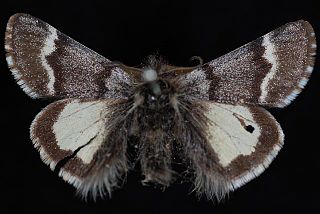
Cactoblastis cactorum, the cactus moth, South American cactus moth or nopal moth, is native to Argentina, Paraguay, Uruguay and southern Brazil. It is one of five species in the genus Cactoblastis that inhabit South America, where many parasitoids, predators and pathogens control the expansion of the moths' population. This species has been introduced into many areas outside its natural range, including Australia, the Caribbean, and South Africa. In some locations, it has spread uncontrollably and was consequently classified an invasive species. However, in other places such as Australia, it has gained favor for its role in the biological control of cacti from the genus Opuntia, such as prickly pear.

Prionoxystus robiniae, the carpenterworm moth or locust borer, is a moth of the family Cossidae. It was first described by Peck in 1818 and it is found in southern Canada and most of the United States.

Catocala junctura, the joined underwing or Stretch's underwing, is a moth in the family Erebidae. The species was first described by Francis Walker in 1858. It is found throughout temperate North America, ranging from New York and Pennsylvania west to Montana, Colorado, Oklahoma, Arizona, and into Texas, and north to southern Illinois, extreme southern Alberta and Saskatchewan; it has also been recorded west of the Rocky Mountains from California and south-eastern British Columbia. It is typically found near water, where the food plants of its caterpillar larvae grow plentifully.

Acronicta hasta, the forked dagger moth, speared dagger moth, cherry dagger moth or dart dagger moth, is a moth of the family Noctuidae. The species was first described by Achille Guenée in 1852. It is found in North America in the eastern deciduous woodlands, ranging west across southern Saskatchewan and Alberta into central southern British Columbia, south to Tennessee, Wisconsin and Kansas.

Hemileuca hera, the sagebrush sheep moth or Hera buckmoth, is a moth of the family Saturniidae. The species was first described by Thaddeus William Harris in 1841. It is found in North America from southern Saskatchewan west to British Columbia, south to Arizona and New Mexico.

Euxoa catenula is a species of moth of the family Noctuidae first described by Augustus Radcliffe Grote in 1879. It is found in North America from southern Saskatchewan west to southern Vancouver Island, south to Kansas, New Mexico, Arizona and southern California.

Syngrapha microgamma, the little bride looper moth, is a moth of the family Noctuidae. The species was first described by Jacob Hübner in 1823. It is found in much of Canada south in the east to southern Maine, northern New York, and the Great Lakes states. In Europe, it is found from Fennoscandia and central Europe east to mountains eastern Asia.
Copablepharon longipenne, the dusky dune moth, is a moth of the family Noctuidae. The species was first described by Augustus Radcliffe Grote in 1882. It is found in North America from south-western Manitoba to southern Alberta, south to western Texas.

Heliothis ononis, the flax bollworm, is a moth of the family Noctuidae. The species was first described by Michael Denis and Ignaz Schiffermüller in 1775. It is found in China, Kazakhstan, central Asia, northern Mongolia (Khangai), the Russian Far East, the Korean Peninsula, southern European part of Russia, southern and central Europe, southern and eastern Siberia and Turkey. In North America it is found from south-central Manitoba west to British Columbia, north to the Northwest Territories and Yukon and Alaska and south to Colorado.

Besma quercivoraria, the oak besma, is a moth of the family Geometridae. The species was first described by Achille Guenée in 1857. It is found across southern Canada and all of the United States except California.

Melitara dentata, the North American cactus moth, is a moth of the family Pyralidae. The species was first described by Augustus Radcliffe Grote in 1876. It is native to western North America, where it is widespread from Alberta to southern Arizona and central Texas. It is an introduced species in Hawaii.
Melitara prodenialis is a moth of the family Pyralidae described by Francis Walker in 1863. It is native to North America, where it is known from south-eastern New York to Florida along the Atlantic coastal plain, and west to eastern Oklahoma and north-central and south-eastern Texas. It is an introduced species in Hawaii. It is a special concern species in Connecticut.

Scopula frigidaria is a moth of the family Geometridae. It was described by Heinrich Benno Möschler in 1869. It is found from Fennoscandia to the Kamchatka Peninsula and in northern North America, where it occurs across the boreal forest region, from Alaska across the Northwest Territories and Nunavut to Newfoundland, and in the mountains south to southern Wisconsin, Alberta and British Columbia.

Leucobrephos brephoides, the scarce infant moth, is a moth of the family Geometridae. The species was first described by Francis Walker in 1857. It is found in North America from Yukon to Labrador and south to New York and southern Alberta and British Columbia.
Melitara texana is a species of snout moth in the genus Melitara. It was described by Herbert H. Neunzig in 1997 and is found in southern Texas and adjacent Mexico.
Melitara doddalis is a species of snout moth in the genus Melitara. It was described by Harrison Gray Dyar Jr. in 1925, and is found in the United States in southern Arizona, southern New Mexico, south-western Texas and in northern Mexico.
Melitara junctolineella is a species of snout moth in the genus Melitara. It was described by George Duryea Hulst in 1900. It is found in southern Texas and Mexico. The species has been introduced in Australia as a biological control agent of Opuntia stricta.
Ozamia fuscomaculella is a species of snout moth in the genus Ozamia. It was described by William S. Wright in 1916. It is found in the US state of California.

Spilosoma dubia, the dubious tiger moth, is a moth in the family Erebidae. It was described by Francis Walker in 1855. It is found from south-eastern Canada west to Alberta and in the eastern United States. The habitat consists of aspen parkland and southern boreal forests.

Plagiomimicus spumosum, the frothy moth, is a moth of the family Noctuidae. The species was first described by Augustus Radcliffe Grote in 1874. It is found in North America, where it has a transcontinental range in the United States, north to southern Ontario and southern Alberta.













